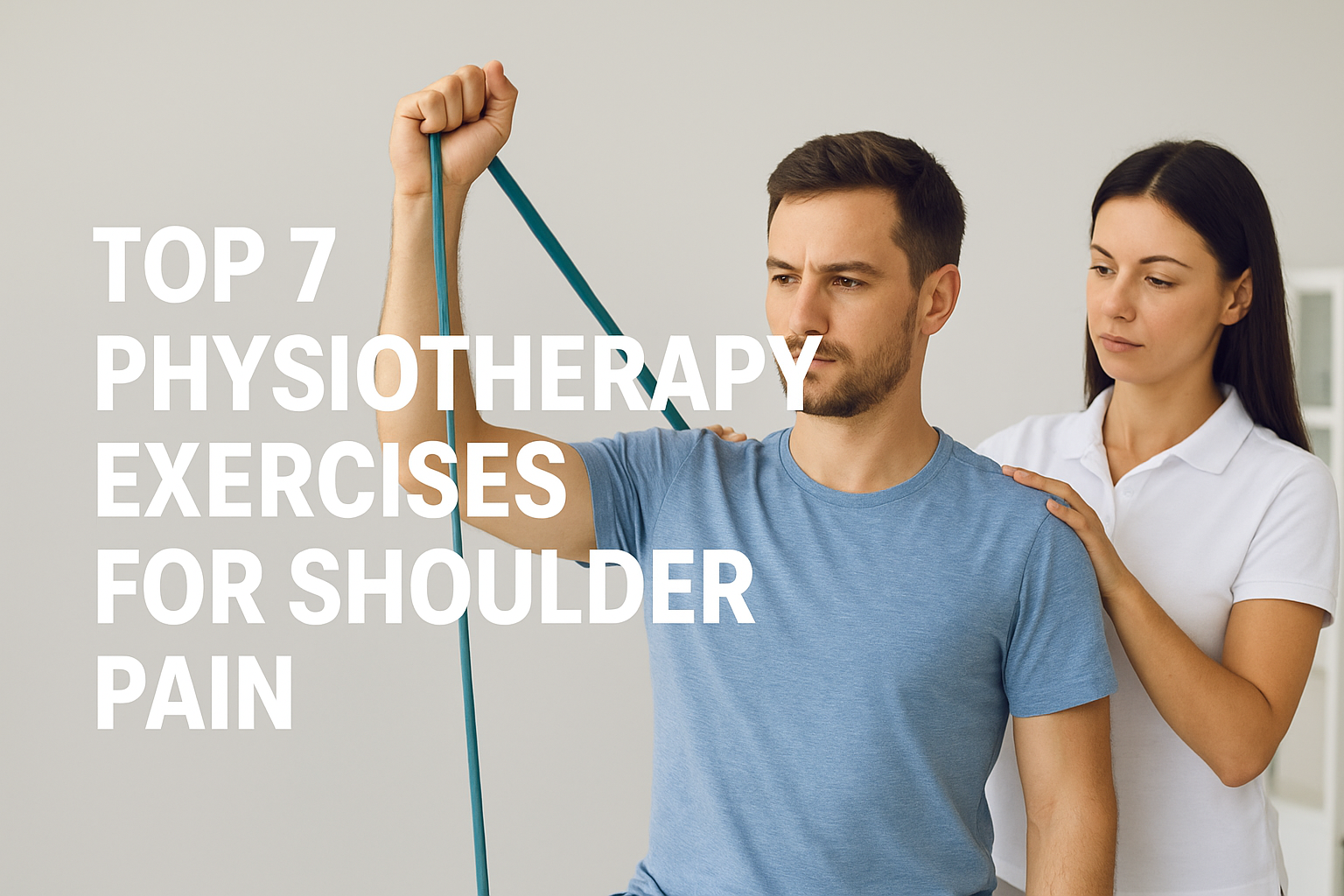Introduction: Relieve Shoulder Pain Naturally with Physiotherapy
Shoulder pain can make even the simplest tasks—like lifting a cup or reaching overhead—feel challenging. Whether it’s from poor posture, overuse, or an old injury, physiotherapy offers safe and effective joint remedies to restore mobility and strength.
Physiotherapy focuses on specific exercises that target shoulder joints, muscles, and tendons. These exercises not only reduce pain but also prevent future stiffness or injuries. According to a 2024 study in the Journal of Orthopaedic Rehabilitation, consistent shoulder physiotherapy exercises improved joint flexibility by up to 60% in patients with mild to moderate pain.
Let’s explore the top 7 physiotherapy exercises that can help relieve shoulder pain and bring back your full range of motion—naturally and effectively.
1. Pendulum Swing (Gentle Mobility Exercise)
Purpose: Improves circulation and eases stiffness in the shoulder joint.
How to do it:
- Lean forward slightly, supporting yourself with one hand on a table.
- Let the affected arm hang freely.
- Gently swing it in small circular motions (clockwise and counterclockwise) for 30–60 seconds.
Tip: Avoid lifting your arm forcefully. This exercise should feel relaxing, not painful.
2. Shoulder Blade Squeeze (Posture Correction)
Purpose: Strengthens upper back muscles and improves posture—key for long-term shoulder pain relief.
How to do it:
- Sit or stand upright.
- Pull your shoulder blades together, holding for 5 seconds.
- Relax and repeat 10–15 times.
Tip: Keep your neck relaxed and shoulders down during the movement.
3. Wall Angels (Mobility + Alignment)
Purpose: Enhances shoulder mobility and reduces stiffness in the shoulder blades and upper spine.
How to do it:
- Stand with your back against a wall, arms bent at 90°.
- Slowly raise your arms upward like a snow angel, keeping elbows and wrists touching the wall.
- Lower them back down. Repeat 10 times.
Tip: Move slowly and avoid arching your lower back.
4. External Rotation with Resistance Band
Purpose: Strengthens rotator cuff muscles responsible for shoulder stability.
How to do it:
- Attach a resistance band to a door handle.
- Hold the band with your elbow bent at 90°, close to your body.
- Rotate your arm outward, away from your torso.
- Slowly return to start. Do 2 sets of 10 reps.
Tip: Keep your movements slow and controlled—avoid jerking.
5. Crossover Arm Stretch
Purpose: Relieves tension in the back of the shoulder and increases flexibility.
How to do it:
- Bring your right arm across your chest.
- Use your left hand to gently pull it closer.
- Hold for 20–30 seconds, then switch sides.
Tip: You should feel a mild stretch—not pain—in your shoulder muscles.
6. Towel Stretch (Internal Rotation Exercise)
Purpose: Improves shoulder flexibility and internal rotation, especially after injuries or surgery.
How to do it:
- Hold a towel behind your back with one hand overhead and the other below.
- Gently pull the towel upward with your top hand to stretch the lower shoulder.
- Hold for 15–20 seconds, then switch sides.
Tip: Perform slowly—avoid overstretching.
7. Shoulder Flexion Using a Wall
Purpose: Increases range of motion and relieves stiffness.
How to do it:
- Stand facing a wall.
- Place your fingertips on it and slowly “walk” your fingers upward as high as you can without pain.
- Hold for 5 seconds, then return down. Repeat 10–15 times.
Tip: As flexibility improves, try going higher each session.
Additional Physiotherapy Tips for Shoulder Joint Health
Incorporate these tips for better recovery and long-term relief:
- Apply warm compresses before exercise to relax stiff muscles.
- Use cold packs after workouts to reduce inflammation.
- Maintain good posture while sitting or working at a desk.
- Avoid sudden overhead lifting during the early recovery phase.
- Consult a physiotherapist if pain persists beyond 2 weeks.
Combining these shoulder exercises with manual therapy and posture correction can significantly reduce pain and restore normal function.
Conclusion: Strengthen, Stretch, and Stay Pain-Free
Physiotherapy is one of the most effective and non-invasive ways to treat shoulder pain. With consistent practice of these top 7 exercises, you can improve joint strength, reduce stiffness, and regain pain-free movement.
Remember — the key is consistency and gentle progress. Start slow, listen to your body, and seek professional guidance when needed. With the right approach, your shoulders can heal naturally and stay strong for life.
FAQs Section
Which exercise is best for shoulder pain relief?
The pendulum swing and external rotation with a resistance band are among the most effective physiotherapy exercises for relieving shoulder stiffness and pain.
How often should I do shoulder physiotherapy exercises?
Perform these exercises 5–6 days a week, with gentle stretching daily and strengthening 3 times a week for best results.
Can physiotherapy cure shoulder pain completely?
Yes, in most mild-to-moderate cases. Consistent physiotherapy and proper posture correction can eliminate pain and prevent recurrence.
Should I do these exercises if I have a rotator cuff injury?
Yes, but only under a physiotherapist’s supervision. Start with light movements and avoid overexertion.
When should I see a physiotherapist?
If pain persists for more than 2 weeks or if you experience swelling, weakness, or sharp pain, consult a licensed physiotherapist.

